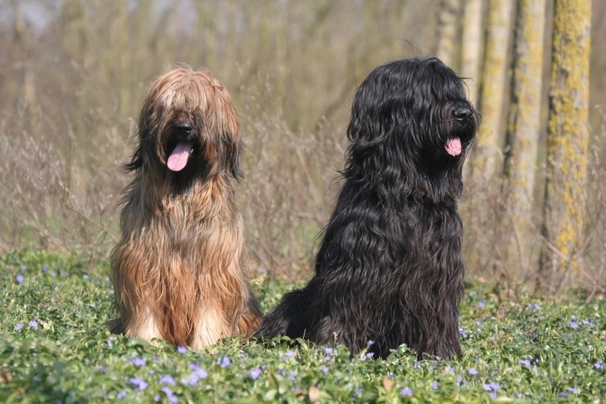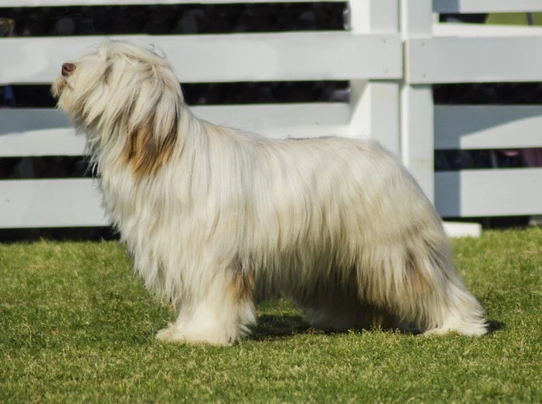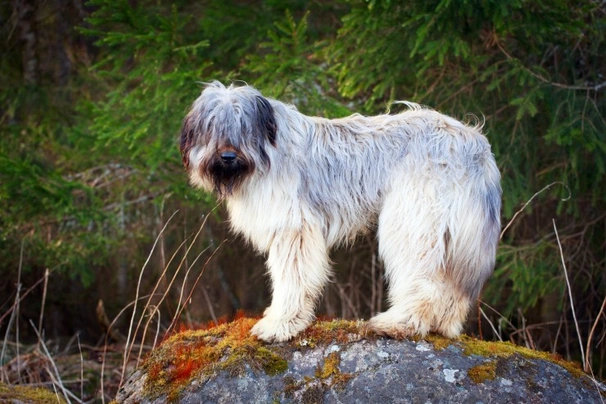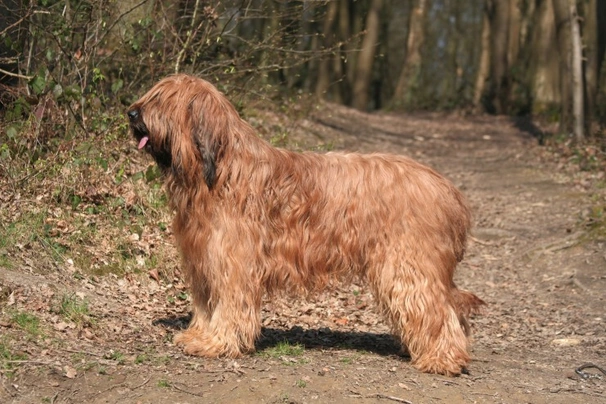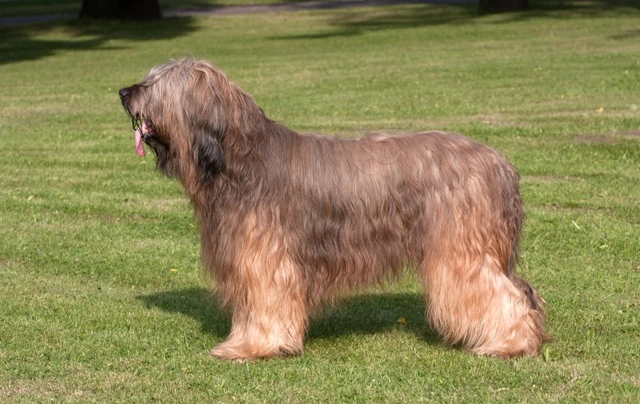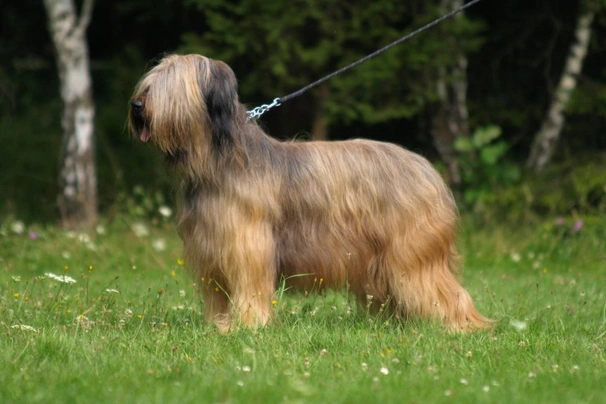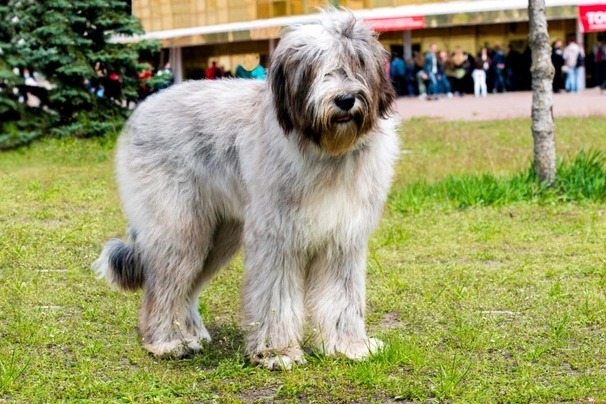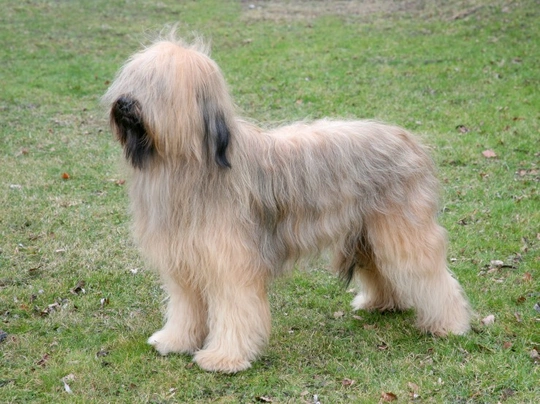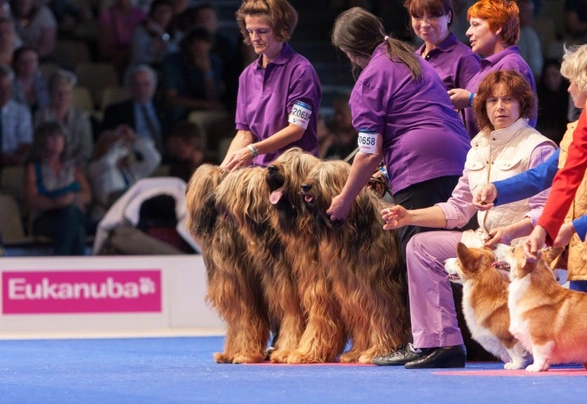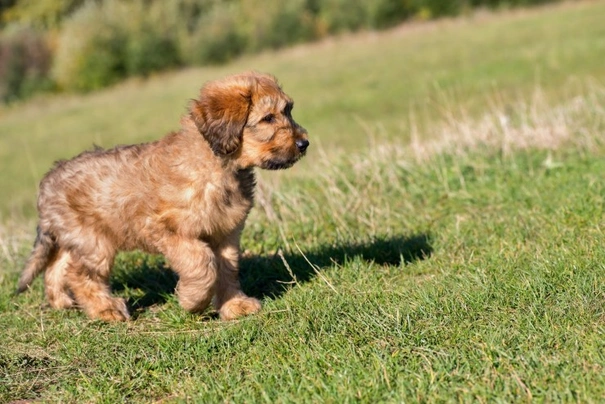Briard
Pros
Cons
Introduction of the Briard
Briards are handsome large dogs with their striking long flowing coats. They were originally bred as working dogs herding and guarding flocks of sheep in France where they were highly valued for their alert kind and loyal natures. They are known to be extremely courageous but rarely would a Briard show any sort of aggressive behaviour unless they feel threatened in any way.
They thrive in a home environment being especially patient and tolerant around children of all ages. However Briards must be trained with a gentle yet firm hand because these large dogs are not aware of their size or their strength. Their coats may be glorious but they are high maintenance on the grooming front and dogs need a minimum of 2-hour’s daily exercise to be truly happy. With this said the Briard is not the best choice for first time dog owners being better suited to people who are familiar with the needs of such a large and extrovert dog.
History of the Briard
The origins of the Briard remain a bit of a mystery but there are many legends about the breed. With this said it is thought that they are one of the oldest French breeds that could well date back to Charlemagne with similar looking dogs being portrayed in tapestries. There are some people who believe very similar dogs were around in the Middle Ages when dogs that arrived in Europe from the Orient were crossed with local herding dogs. The goal it is said was to create a larger more fearless dog that was capable of guarding and herding flocks of sheep and a dog that boasted enough courage to take on wolves and other large predators without hesitation. The breed is thought to be a descendant of Aubry's dog and were given their name from the region of France known as Brie where they were developed.
It was the French who developed the Briard and in ancient times these dogs were highly prized for their intelligence courage yet kind natures which led to many legends being told about them. They not only worked as herding and guard dogs but the Briard also worked with the military. Napoleon took Briards with his armies on his many campaigns. Thomas Jefferson was so impressed with the breed he took several back to the States where they were to work with American farmers. Lafayette had some dogs sent to his estate and pretty soon they were to become highly prized not only in their native France but in America too.
The Briard was so highly thought of the breed was made the French army's official dog and during the wars they would carry supplies to soldiers on the front lines they tracked wounded soldiers and even worked as sentries. On the battlefield Briards appeared to know which wounded soldiers needed help and who were beyond help which can be put down to their superb hearing and superior intelligence. Sadly breed numbers were drastically depleted at the end of the war.
The breed first arrived on British shores in the late 1960’s when dogs were imported from Ireland to England and the first Briard to be exhibited in the UK was in 1967 with 2 dogs then qualifying for Crufts. The British Briard Club was established in 1973 and a year later the Kennel Club granted the breed full championship status. Today these magnificent large dogs are still highly prized in France but they have become sought after in other parts of the world including here in the UK thanks to their handsome looks and their kind loyal natures.
Interesting facts about the breed
- Is the Briard a vulnerable breed? No although finding a healthy well-bred puppy in the UK can prove challenging and as a result they are expensive
- In France the breed is known as the Chien Berger De Brie and the Sheepdog of Brie
- There are stories that Napoleon owned 2 Briards
- A dog called “Desamee Mitzi Moffat” was the first Briard Champion at Crufts
Appearance of the Briard
Height at the withers: Males 61 - 69 cm Females 58 - 65 cm
Average weight: Males 30 - 40 kg Females 25 - 35 kg
These large dogs have an unusual physical trait in that they have double dewclaws on their back legs as well as single ones on their front ones. The Briard stands out in the crowd thanks to their long flowing coats their charming moustaches beards and bushy eyebrows. With this said they are well-proportioned boasting a rugged yet athletic and supple appearance. Their head is ever so slightly rounded with a nice square strong looking muzzle and clearly defined stop. A Briard’s nose is always black regardless of the colour of their coat.
They boast large dark brown eyes with black rims that always have a very intelligent and gentle expression in them. Ears are covered in long hair and set high on a dog’s head which they carry slightly lifted when alert. The Briard has a very strong mouth with a perfect scissor bite where their upper teeth neatly overlap their lower ones all set on a nice square jaw and their lips are always black in colour.
They have moderately long and well-muscled necks that dogs carry arched adding to their proud appearance. Shoulders are well laid back and set at a nice angle with dogs boasting strong well-muscled front legs. Chests are broad with dogs having a strong level back and medium spring ribcage that drops well down. These dogs boast a slight slope at their croup where their tail is set.
Hindquarters are well angulated with dogs boasting strong well developed back legs and double dewclaws which are set low. Feet are strong and slightly round very reminiscent of a cat or hare’s foot. Nails are black with dogs having hard pads and well closed toes all of which are profusely covered in hair. The Briard has a long tail that’s covered in hair which dogs carry low but always in line with their backs.
When it comes to their coat the Briard has a long and slightly wavy coat with a very fine and dense undercoat that covers their entire body. They have a moustache beard and eyebrows that slightly veil their eyes. Accepted colours for Kennel Club registration are as follows:
- Black
- Fawn – all shades
- Slate Grey
Briards with fawn coloured coats can have darker markings on their muzzles ears backs and on their tails which is acceptable with the proviso that colours blend in nicely in with the rest of their coat colour.
It is worth noting that acceptable colours for Kennel Club registration can differ from the colours set out in the Breed Standard.
Gait/movement
When a Briard moves they do so with an effortless gait taking long strides and covering a lot of ground when they do. They are also extremely adept at turning on a sixpence showing a tremendous amount of drive while remaining well balanced strong smooth and firm.
Faults
The Kennel Club frowns on any exaggerations or departures from the breed standard and would judge the faults on how much they affect a dog's overall health and wellbeing as well as their ability to perform.
Males should have both testicles fully descended into their scrotums and it is worth noting that a dog can be a little lighter or heavier as well as slightly taller or shorter than set out in the Kennel Club breed standard which is only given as a guideline.
Temperament of the Briard
The Briard is a highly intelligent dog and one that boasts having a tremendous amount of courage yet they never show any signs of aggressive behaviour but rather a gay energetic and lively nature which are just some of the reasons why they are so highly thought of not only in their native France but in other regions of the world too.
Because they are fun-loving energetic by nature they adapt tremendously well to family life. They literally don't have a nasty bone in their body and adore taking part in any sort of interactive game. However they do need to be kept busy and their education needs to start early for them to grow up to be well-rounded adult dogs. Briard puppies need to be well socialised from a young age which means introducing them to new situations people and animals too.
Briards are not the best choice for first time owners because they need to be correctly handled and trained right from the word go. They are happy when they know their place in the pack and who is alpha dog in a household. Their training always has to be consistent and fair with dogs needing to be handled with a firm yet gentle hand. They also need to be given a ton of daily exercise which has to include lots of mental stimulation for them to be truly happy obedient dogs.
Are they a good choice for first time owners?
Briards are not the best choice for first time dog owners because they need to be socialised handled and trained by people who are familiar with the needs of such large intelligent and often boisterous and stubborn dogs that can often show a more dominant side to their natures.
What about prey drive?
Briards were bred to guard and herd large flocks and as such they do have a high prey drive and like nothing better than to chase anything that moves or tries to run away. As such care must always be taken as to where and when a Briard can run off the lead more especially if there is livestock and wildlife close by. They also like to nip at the heels of whatever they are trying to move along which includes children.
What about playfulness?
Briards have the reputation of being real “extroverts” they have a mischievous playful and fun-loving side to their natures. With this said owners must be careful not to mix up playfulness with dominance which can happen if a Briard gets away with too much. The other thing to bear in mind is that Briards do not know their own strength and can be extremely boisterous when the mood takes them and are known to jump up at people which could easily knock a person over.
What about adaptability?
Briards being so large and exuberant need to have enough space to express themselves and are much better suited to households with large secure back gardens where a dog can safely let of steam whenever possible.
What about separation anxiety?
Although Briards form strong ties with their families they do not generally suffer from separation anxiety providing they are never left to their own devices for too long. With this said they are better suited to people who lead active outdoor lives and who like to have an intelligent energetic large canine companion at their side.
What about excessive barking?
Briards can be very protective of their families and property which means they can take to barking incessantly if they feel things are not as they should be. With this said Briards don’t generally bark just for the sake of it and usually only voice an opinion when they feel it is necessary to do so.
Do Briards like water?
Most Briards love swimming and will take to the water whenever they can more especially when the weather is hot. However if anyone who owns a dog that does not like water should never force them to go in because it would just end up scaring them. With this said care should always be taken when walking a Briard off the lead anywhere near more dangerous watercourses just in case a dog decides to leap in and then needs rescuing. It is also very important to dry off a dog’s coat when they get wet to prevent moisture from being trapped which could lead to an allergy flare-up.
Are Briards good watchdogs?
Briards are natural watchdogs which is a trait that is deeply embedded in their psyche. As such they do not need to be taught to guard or protect. With this said rarely would a Briard show any sort of aggression towards anyone providing they don’t feel threatened. However as previously mentioned some Briards object to strangers approaching their owners and will make sure the people understand their displeasure at the situation.
Intelligence / Trainability of the Briard
It's essential for a Briard's training and education to start as early as possible or these lovely dogs might start to show a more dominant side to their characters. Puppies as previously mentioned need to be well socialised from a young age so they grow up to be receptive and obedient adult dogs. In the right hands with the correct amount of positive reinforcement training a Briard is a joy to be with but their education and training has to be consistent and owners need to show a lot of patience towards them.
These dogs need to be handled firmly yet gently to achieve the right sort of results. They do not respond well to harsh correction or training which could end up doing more harm than good. Briards tend to form a very strong bond with one member of the family but they are always loving towards everyone in a household. They are known to be wary and suspicious of people they don't know but would rarely show any sort of aggression towards them.
Like all puppies Briard puppies are extremely cute with their shaggy appearance and adorable looks. However a sweet puppy quickly grows up to be a large mature dog and as such once a puppy is settled into a new home they must be taught the rules and boundaries of what is acceptable behaviour and what is not. It also helps establish a “pecking order” and who is the alpha dog in a household. The first commands a puppy should be taught are as follows:
- Come
- Sit
- Stay
- Heel
- Quiet
- Leave it
- Down
- Bed
Children and other
Briards are known to be a great choice as family pets because they are so protective by nature. However they can become over protective of children which is something parents need to watch out for and gently correct when necessary. As with any other large dog any interaction between a Briard and the kids has to be well supervised by an adult to make sure play time does not get too boisterous.
Briards are generally good around other dogs although they can show a more dominant side to their nature if they have not been correctly trained and handled when young. If these dogs are carefully and properly introduced to other pets and animals in a household they will usually accept and tolerate being around them.
Health of the Briard
The average life expectancy of a Briard is between 11 and 15 years when properly cared for and fed an appropriate good quality diet to suit their ages.
Briards are known to be one of the healthier pedigree dogs around and although the breed was known to suffer from hip dysplasia thanks to careful and selective breeding fewer cases are now reported. With this said if you are hoping to share a home with a Briard there are a few health concerns worth knowing about which includes the following:
- Hip dysplasia – dogs must be hip scored under the BVA/KC hip dysplasia scheme – the mean score for Briards is 13.7 and parent dogs should be lower than this
- Congenital stationery night blindness (CSNB) – dogs must be DNA tested through the Animal Health Trust (AHT)
- Retinal epithelial dystrophy (RPED or CPRA) – dogs should be eye tested annually through the BVA/KC eye scheme
- Non-malignant skin tumours
- Ectopic ureter
- Bloat/gastric torsion
It is worth noting that the Kennel Club’s breed average COI stands at 5.1%.
What about vaccinations?
Briard puppies would have been given their initial vaccinations before being sold but it is up to their new owners to make sure they have their follow-up shots in a timely manner with the vaccination schedule for puppies being as follows:
- 10 -12 weeks old bearing in mind that a puppy would not have full protection straight away but would be fully protected 2 weeks after they have had their second vaccination
There has been a lot of discussion about the need for dogs to have boosters. As such it's best to talk to a vet before making a final decision on whether a dog should continue to have annual vaccinations which are known as boosters.
What about spaying and neutering?
A lot of vets these days recommend waiting until dogs are slightly older before spaying and neutering them which means they are more mature before undergoing the procedures. As such they advise neutering males and spaying females when they are between the ages of 6 to 9 months old and sometimes even when a dog is 12 months old.
Other vets recommend spaying and neutering dogs when they are 6 months old but never any earlier unless for medical reasons. With this said many breeds are different and it is always advisable to discuss things with a vet and then follow their advice on when a dog should be spayed or neutered.
What about obesity problems?
Like other breeds some Briards gain weight after they have been spayed or neutered and it's important to keep an eye on a dog's waistline just in case they do. If a dog starts to put on weight it's important to adjust their daily calorie intake and to up the amount of exercise they are given. Older dogs too are more prone to gaining weight and again it's essential they be fed and exercised accordingly because obesity can shorten a dog's life by several years. The reason being that it puts a lot of extra strain on a dog's internal organs including the heart which could prove fatal.
What about allergies?
Some Briards are prone to suffering from allergies and it's important for a dog to see a vet sooner rather than later if one flares up. Allergies can be notoriously hard to clear up and finding the triggers can be challenging. With this said a vet would be able to make a dog with an allergy more comfortable while they try to find out the triggers which could include the following:
- Certain dog foods that contain high levels of grains and other cereal type fillers
- Airborne pollens
- Dust mites
- Environment
- Flea and tick bites
- Chemicals found in everyday household cleaning products
Participating in health schemes
All responsible Briard breeders would ensure that their stud dogs are tested for known hereditary and congenital health issues known to affect the breed by using the following schemes:
What about breed specific breeding restrictions?
As of January 1st 2016 the Kennel Club no longer accepts the registration of puppies from litters born to parents known to carry the CSNB gene that have been bred to clear dogs whether they are DNA tested or hereditary clear. It is worth noting that each case can be dealt with by the Kennel Club on a case-by-case basis and permission can be granted prior to a proposed mating. It is also worth noting that if the Kennel Club does grant permission all puppies produced from such matings must be DNA tested and then registered as either CSNB Clear or Carriers.
What about Assured Breeder Requirements?
It is mandatory for all Kennel Club Assured breeders to use the following tests on their dogs and the KC strongly recommends that all other breeders follow suit:
The Kennel Club also strongly recommends that all breeders use the following test on their dogs:
Caring for the Briard
As with any other breed Briards need to be groomed on a regular basis to make sure their coats and skin are kept in top condition. They also need to be given regular daily exercise to ensure they remain fit and healthy. On top of this they need to be fed good quality food that meets all their nutritional needs throughout their lives.
Caring for a Briard puppy
Briard puppies can be extremely boisterous and full of life which means it's essential for homes and gardens to be puppy-proofed well in advance of their arrival. A responsible breeder would have well socialised their puppies which always leads to more outgoing confident and friendly dogs right from the word go. With this said any puppy is going to feel vulnerable when they leave their mother and littermates which must be taken into account. The longer a puppy can remain with their mother the better although it should never be for too long either.
It's best to pick a puppy up when people are going to be around for the first week or so which is the time needed for a puppy to settle in. Puppy-proofing the home and garden means putting away any tools and other implements that a boisterous puppy might injure themselves on. Electric wires and cables must be put out of their reach because puppies love chewing on things. Toxic plants should be removed from flowerbeds and the home too.
Puppies need to sleep a lot to grow and develop as they should which means setting up a quiet area that's not too out of the way means they can retreat to it when they want to nap and it's important not to disturb them when they are sleeping. It's also a good idea to keep "playtime" nice and calm inside the house and to have a more active "playtime" outside in the garden which means puppies quickly learn to be less boisterous when they are inside.
The documentation a breeder provides for a puppy must have all the details of their worming date and the product used as well as the information relating to their microchip. It is essential for puppies to be wormed again keeping to a schedule which is as follows:
- Puppies should be wormed at 6 months old
- They need to be wormed again when they are 8 months old
- Puppies should be wormed when they are 10 months old
- They need to be wormed when they are 12 months old
Things you'll need for your puppy
There are certain items that new owners need to already have in the home prior to bringing a new puppy home. It's often a good idea to restrict how much space a puppy plays in more especially when you can't keep an eye on what they get up to bearing in mind that puppies are often quite boisterous which means investing in puppy gates or a large enough playpen that allows a puppy the room to express themselves while keeping them safe too. The items needed are therefore as follows:
- Good quality puppy or baby gates to fit on doors
- A good well-made playpen that's large enough for a puppy to play in so they can really express themselves as puppies like to do
- Lots of well-made toys which must include good quality chews suitable for puppies to gnaw on bearing in mind that a puppy will start teething anything from when they are 3 to 8 months old
- Good quality feed and water bowls which ideally should be ceramic rather than plastic or metal
- A grooming glove
- A slicker brush or soft bristle brush
- Dog specific toothpaste and a toothbrush
- Scissors with rounded ends
- Nail clippers
- Puppy shampoo and conditioner which must be specifically formulated for use on dogs
- A well-made dog collar or harness
- A couple of strong dog leads
- A well-made dog bed that's not too small or too big
- A well-made dog crate for use in the car and in the home that's large enough for a puppy to move around in
- Baby blankets to put in your puppy's crate and in their beds for when they want to nap or go to sleep at night
Keeping the noise down
All puppies are sensitive to noise including Briard puppies. It's important to keep the noise levels down when a new puppy arrives in the home. TVs and music should not be played too loud which could end up stressing a small puppy out which could end up making them withdrawn timid and shy.
Keeping vet appointments
As previously mentioned Briard puppies would have been given their first vaccinations by the breeders but they must have their follow up shots which is up to their new owners to organise. The vaccination schedule for puppies is as follows:
- 10 -12 weeks old bearing in mind that a puppy would not have full protection straight away but would only be fully protected 2 weeks after they have had their second vaccination
When it comes to boosters it's best to discuss these with a vet because there is a lot of debate about whether a dog really needs them after a certain time. However if a dog ever needed to go into kennels their vaccinations would need to be fully up to date.
What about older Briards when they reach their senior years?
Older Briards need lots of special care because as they reach their golden years they are more at risk of developing certain health concerns. Physically a dog's muzzle may start to go grey but there will be other noticeable changes too which includes the following:
- Coats become coarser
- A loss of muscle tone
- Briards can either become overweight or underweight
- They have reduced strength and stamina
- Older dogs have difficulty regulating their body temperature
- They often develop arthritis
- Immune systems do not work as efficiently as they once did which means dogs are more susceptible to infections
- Older dogs change mentally too which means their response time tends to be slower as such they develop the following:
- They respond less to external stimuli due to impaired vision or hearing
- They tend to be a little pickier about their food
- They have a lower pain threshold
- Become intolerant of any change
- Often an older dog can feel disorientated
Living with a Briard in their golden years means taking on a few more responsibilities but these are easily managed and should include looking at their diet the amount of exercise they are given how often their dog beds need changing and keeping an eye on the condition of their teeth.
Older Briards need to be fed a good quality diet that meets their needs at this stage of their lives all the while keeping a close eye on a dog's weight. A rough feeding guide for older dogs is as follows bearing in mind they should be fed highly digestible food that does not contain any additives:
- Protein content should be anything from 14 – 21%
- Fat content should be less than 10%
- Fibre content should be less than 4%
- Calcium content should be 0.5 – 0.8%
- Phosphorous content should be 0.4 – 0.7%
- Sodium content should be 0.2 – 0.4%
Older Briards don't need to be given the same amount of daily exercise as a younger dog but they still need the right amount of physical activity to maintain muscle tone and to prevent a dog from putting on too much weight. All dogs need access to fresh clean water and this is especially true of older dogs when they reach their golden years because they are more at risk of developing kidney disorders.
Grooming of the Briard
Briards are high maintenance on the grooming front because their coats need to be brushed daily to avoid any knots or tangles from forming. Briard puppies must be taught that a grooming session is a pleasant experience and one that they look forward to. It’s also very important to check between a dog’s toes regularly to see if anything is trapped which could lead to an infection flaring up. Dew claws also need to be trimmed regularly to prevent them snagging on things. Their coats also need to be regularly trimmed which is best left up to a professional dog groomer. Because Briards boast coarse double coats they do tend to shed quite a bit and more especially during the Spring and then again in the Autumn which is when more frequent brushing would be necessary.
It's also essential to regularly check a Briard's ears because if there is too much hair in them this needs to be removed. If left a dog is more at risk of developing an ear infection and these can be notoriously hard to treat once they flare up. The hair that grows between a dog's pads also needs to be regularly trimmed to avoid it balling up which could make walking uncomfortable for dogs especially during the winter months.
Exercise of the Briard
Briards are very intelligent and energetic dogs and as such they need to be given a heap of exercise and mental stimulation every day. This means a good walk in the morning and then a longer more interesting one in the afternoon. Ideally Briards need 2 hours exercise a day so they can expend all that pent-up energy.
These dogs also benefit from being able to run around a back garden as often as possible so they can really let off steam. However the fencing the garden must be high and very secure to keep these high energy dogs in. Briards also love to swim which means care should be taken when walking them anywhere near water where they can safely be off their leads because they might just decide to jump in.
Feeding of the Briard
If you get a Briard puppy from a breeder they would give you a feeding schedule and it's important to stick to the same routine feeding the same puppy food to avoid any tummy upsets. You can change a puppy's diet but this needs to be done very gradually always making sure they don't develop any digestive upsets and if they do it's best to put them back on their original diet and to discuss things with the vet before attempting to change it again.
Older dogs are not known to be fussy or finicky eaters but this does not mean you can feed them a lower quality diet. It's best to feed a mature Briard twice a day once in the morning and then again in the evening making sure it's good quality food that meets all their nutritional requirements. It's also important that dogs be given the right amount of exercise so they burn off any excess calories or they might gain too much weight which can lead to all sorts of health issues. Obesity can shorten a dog's life by several years so it's important to keep an eye on their waistline from the word go.
One of the more serious health concerns with Briards is the fact they are prone to suffer from bloat (gastric torsion) and as such care has to be taken when they are fed. It's best for these dogs to be fed twice a day rather than giving them one meal a day. It's also important not to feed a Briard just before or just when they come back from a walk because by doing so dogs are put at greater risk of developing bloat.
Feeding guide for a Briard puppy
Puppies need to be fed a highly nutritious good quality diet for them to develop and grow as they should. As a rough guide a Briard puppy should be fed the following amounts every day making sure their meals are evenly spread out throughout the day and it's best to feed them 3 or 4 times a day:
- 2 months old - 265g to 307g depending on a puppy's build
- 3 months old - 327g to 364g depending on a puppy's build
- 4 months old - 354g to 405g depending on a puppy's build
- 6 months old - 405g to 549g depending on a puppy's build
- 8 months old - 404g to 604g depending on a puppy's build
- 10 months old - 370g to 543g depending on a puppy's build
- 12 months old - 334g to 462g depending on a puppy's build
- 14 months old - 331g to 453g depending on a puppy's build
Once a Briard is 16 months old they can be fed adult food.
Feeding guide for an adult Briard
Once fully mature an adult Briard must be fed a good quality diet to ensure their continued good health. As a rough guide an adult Briard can be fed the following amounts every day:
- Dogs weighing 25kg can be fed 285g to 435g depending on activity
- Dogs weighing 30kg can be fed 318g to 485g depending on activity
- Dogs weighing 35 kg can be fed 349g to 532g depending on activity
- Dogs weighing 40 kg can be fed 394g to 601g depending on activity
Briard price
If you are looking to buy a Briard you would need to pay anything from £600 to over £1000 for a well-bred pedigree puppy. However only very few puppies were registered with the Kennel Club over the last two years which means finding one could be a problem and if you do you may have to go on a long waiting list. The cost of insuring a male 3-year-old Briard in northern England would be £23.91 a month for basic cover but for a lifetime policy this would set you back £84.56 a month (quote as of March 2018). When insurance companies calculate a pet's premium they factor in several things which includes where you live in the UK and a dog's age and whether they have been neutered or spayed.
When it comes to food costs you need to buy the best quality food whether wet or dry to feed your dog throughout their lives making sure it suits the different stages of their lives. This would set you back between £50 - £60 a month. On top of this veterinary costs need to be factored in when sharing a home with a Briard which includes their initial vaccinations their annual boosters the cost of neutering or spaying your dog when the time is right and then their yearly health checks all of which quickly adds up to over a £1000 a year.
As a rough guide the average cost to keep and care for a Briard would be between £100 to £160 a month depending on the level of insurance cover you opt to buy for your dog but this does not include the initial cost of buying a well-bred Kennel Club registered pedigree Briard puppy.
Buying advice
When visiting and buying any puppy or dog there are many important things to consider and questions to ask of the breeder/seller. You can read our generic puppy/dog advice here which includes making sure you see the puppy with its mother and to verify that the dog has been wormed and microchipped.
Over recent times Briards have found a fanbase both in the UK and elsewhere in the world which means that well-bred puppies can often command a lot of money. As such with Briards there is specific advice questions and protocols to follow when buying a puppy which are as follows:
- Beware of online scams and how to avoid them. You may see online and other adverts by scammers showing images of beautiful Briardpuppies for sale at very low prices. However the sellers ask buyers for money up front before agreeing to deliver a puppy to a new home. Potential buyers should never buy a puppy unseen and should never pay a deposit or any other money online to a seller. You should always visit the pet at the sellers home to confirm they are genuine and make a note of their address.
- As previously touched upon Briards have found a fanbase in the UK and as such there are many amateur breeders/people who breed from a dam far too often so they can make a quick profit without caring for the welfare of the puppies their dam or the breed in general. Under Kennel Club rules a dam can only produce 4 litters and she must be between a certain age to do so. Anyone wishing to buy a Briard puppy should think very carefully about who they purchase their puppy from and should always ask to see the relevant paperwork pertaining to a puppy's lineage their vaccinations and their microchipping.
- Prospective owners should also make certain that parent dogs have been CSNB tested before having been used in a breeding programme.

